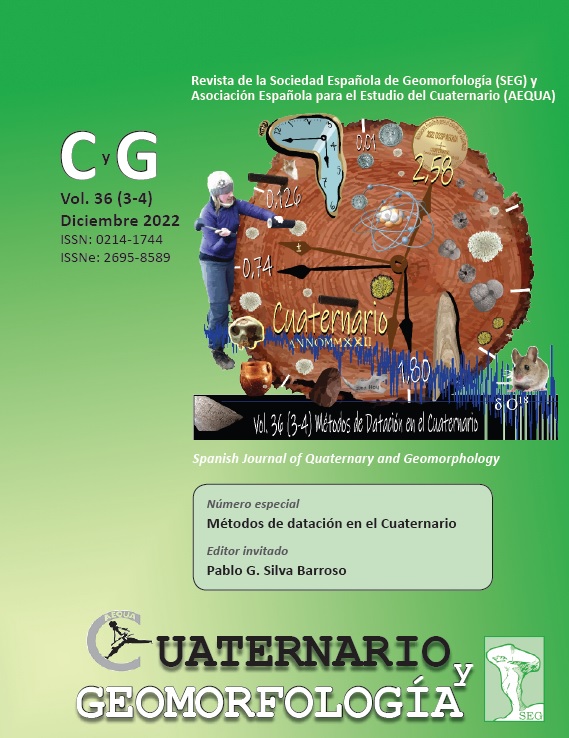Dating in archeology through material culture: potteries, epigraphs and coins
DOI:
https://doi.org/10.17735/cyg.v36i3-4.93656Keywords:
Potteries, Epigraphy, Numismatics, archaeological datingAbstract
The study of certain artifacts, pottery, coins and inscriptions, allows relative or absolute data to be established by themselves. Potteries can provide data with time frames of one or two decades, in the case of certain stamps of potteries or production workshops, and including absolutes due to the appearance of tituli picti. For its part, epigraphy, through the study of inscriptions, makes possible in many cases an absolute dating, thanks to the information collected in writing. Proof of this could be the consular dates or imperial titles that allow knowing with total accuracy the date to which the episode or event they collect mentions. The coin is a continuous document in time since the series succeed one another, in some cases for two or three hundred years, or during the life of a city as is the case of Rome. Although the date of minting is not expressly stated in the ancient coin, there are different procedures for its dating, due to the variety of existing issues and the information contained in them. It is therefore that, within the framework of archaeological research, the information provided by these materials in certain contexts, either thanks to the conjunction of the three, or by one of them, is today the main source for the establishment of chronologies or dates in the Archaeology.
Downloads
References
Abascal, J. M. (1984). Hallazgos arqueológicos y circulación monetaria. Disfunciones metodológicas en el estudio de la Hispania romana. Actas del IX Congreso Nacional de Numismática. Elche. 143-158.
Blanco, A. y Luzón, J. Mª. (1974). El mosaico de Neptuno en Itálica. Patronato del Conjunto arqueológico de Itálica, Sevilla, 60 pp.
Berni, P. (2016). Dressel 20 (Área costera noreste tarraconense), Amphorae ex Hispania. Paisajes de producción y de Consumo (http://amphorae.icac.cat/amphora/dressel-20-tarraconensis-northern-coastal-area) [Consultada 16 de febrero 2022]
Burnett, A. (1991). Interpreting the past. Coins. British Museum Press, Londres (UK), 64 pp.
Calabi Limentani, I. (1973). Epigrafía Latina, Ed. Cisalpino, Milán - Bolonia (Italía). 543 pp.
Degrassi (1962). Scritti vari di antichità, I, Ed. A cura del Comitato d'Onore, Roma (Italia). 1143 pp.
Ettlinger, E. (1990). Conspectus formarum térrea sigillatae italico modo confectae, Ed. R. Habelt, Bonn, 213 pp.
García, E., Martín-Arroyo, D., Lagóstena, L. (2016). Dressel 11 (Costa Bética), Amphorae ex Hispania. Paisajes de producción y de consumo (http://amphorae.icac.cat/amphora/dressel-11-baetica-coast) [Consultada 16 de febrero 2022]
Genin, M. (2007). La Graufesenque (Millau, Aveyron) Vol. II. Sigillées lisses et autres productions, Bordeaux, Aquitania, Ed. De la Féderation Aquitania, 589 pp.
Gurt, J. (1985). Clunia III. Hallazgos monetarios. La romanización de la Meseta Norte a través de la circulación monetaria en la ciudad de Clunia. EAE 145, Madrid, 373 pp.
Hübner, Aem. (1869). Exempla scripturae epigraphicae Latinae a Caesaris dictatoris morte ad aetatem Iustiniani, Berlín, Ed. De Gruyter, 542 pp.
Martínez, F.; Márquez, M. y Sarompas, C. E. (2017). Tituli picti en ánforas olearias béticas alusivos a la statio sel y a la statio sex, hallados en el Monte Testaccio de Roma, y su contexto geo-histórico. CPAG 27, 373-397 https://doi.org/10.30827/cpag.v27i0.8190
Mayet, F. (1984). Les ceramiques sigilles hispaniques, Paris, Publications du Centre Pierre Paris XII; Collection de la Maison des Pays Iberiques 21, 356 pp.
Mezquiriz, M. A. (1961). Terra Sigillata Hispánica, Valencia, The William L. Bryant Foundation, 666 pp.
Moros, J., Berni, P. (2012). "Novedades sobre epigrafía anfórica bética para la zona productora de Adelfa (Carmona, Sevilla)", Ex Officina Hispana, Boletín de la Sociedad de Estudios de la Cerámica Antigua en Hispania (SECAH), nº 3, 34-45.
Pérez Ballester, J. (1995). Las ánforas Dressel 1 con datación consular. Una pieza de Cartagena. Saguntum: Papeles del Laboratorio de Arqueología de Valencia, 29, 175-186
Rodríguez, D. y Mannack (2019). La cerámica Ática y su historiografía. Classica Instrvmenta. Monografías de Historia de Arte e Arqueología. Universidade de Coimbra, 199 pp. https://doi.org/10.14195/978-989-26-1534-9


